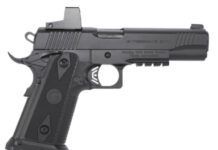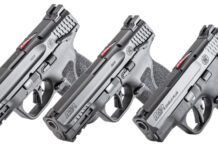Our Marlin came with mighty nicely figured walnut. The buttstock wood matched the wood of the forend, both having prominent contrasting grain and some fiddleback. The wood appeared to have an epoxy-base finish, it being quite hard and scratch-resistant. The checkering was excellent, with decorative touches. It wrapped the forend and was generous at the grip. The butt had a hard-rubber pad that curved to fit the shoulder, though it did little to cut recoil. There were sling studs, too.
The bluing and overall fitting were excellent, though we could have done without all the extra words of warning on the barrel. The sights consisted of a buckhorn rear with a U notch, and a hooded front having a large, flat, gold-faced bead. We thought a good aperture rear sight would have been the way to go, rather than the dated “cowboy” buckhorn rear. The rear sight had the old-style stepped adjustment for elevation, with windage by drifting. The action had well-polished flat sides with matte finish on top, and was fitted with a hammer-blocking cross bolt that could be used or ignored at will. The MX had the overall flavor of the old West, which we found pleasant. The fact that its ballistics match the .308 is cause for celebration, we thought.
The easily loaded tubular magazine held five rounds, and one could be added in the chamber for a total of six. The front of the magazine tube was secured to the barrel via a single screw going into a small carrier dovetailed into the barrel. We found the screw had worked loose after only a few shots. We snugged it up and then kept a wary eye on it, and found that it didn’t want to stay perfectly tight during our extended test shooting. It seemed that as this screw came loose, accuracy tended to deteriorate slightly. However, the Marlin had accuracy to spare, even at its worst.
Feeding, firing and ejection were perfect. The lack of suitable padding in the token recoil pad led to our noticing the kick, but it was not substantial. For those shy of recoil, a softer pad might be appropriate. Our first sight-checking rounds of the iron sights gave us three shots touching at 25 yards, dead center, so it was not necessary to adjust anything. As noted, extraction and ejection.
There was a trace of creep in the trigger, which broke at 5.5 pounds. We felt the future owner of this rifle ought to have that taken care of. With an empty weight of 7.3 pounds this wasn’t a lightweight, but that’s about the only thing we could complain about, concerning the Marlin. The balance and handling were superb. The lever was easy to work with the rifle at the shoulder. The rifle was easily carried with the hand wrapped around the action, which was the static balance point. However, a suitable scope would make the overall weight at least eight pounds, and that’s a good reason to consider a good aperture sight instead of a scope, for those whose eyes permit this.
On the range we found the Marlin was simply outstanding. We made one of the smallest lever-rifle groups ever recorded, with three touching at 50 yards from the machine rest. The group measured just 0.4 inch, not bad for crude cowboy sights. Ejection was clean and easy, and the lever worked easily and smoothly throughout our test sessions. Rapid-fire working of the mechanism was easier, we felt, with the Marlin than with the BLR. We liked this rifle and its new cartridge.































